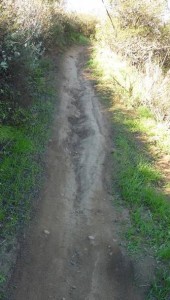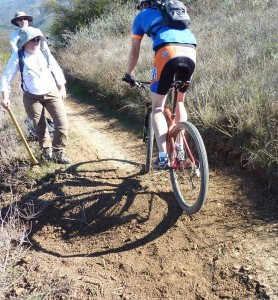
This rut on the Wood Canyon Vista Trail doesn't look like much now, but left to itself, it will evenutally consume the entire trail!
Running water is responsible for well over 90% of trail damage. Last winter we had a lot of rain that heavily damaged the Wood Canyon Vista Trail (and others), leaving it with deep ruts and loose rocks. The State Park maintenance staff fixed the ruts by running a SWECO (mini bulldozer) up the trail, and then new drainage channels were cut by CORBA and other volunteers.
The number one trail maintenance objective is to get the water off the trail to keep new ruts from forming. During normal trail use, a ridge of dirt and rocks forms on the outside edge of the trail. This is called a berm and it keeps the water from running off the trail. We allow the water to drain off by constructing what are called ‘rolling dips’ or ‘grade dips.’ This is done by digging a depression in the trail, a few inches deep and sloped to the downhill side. We also cut out the berm so that water will be diverted off when it runs into the rolling dip. Downhill of this depression, we build a low mound called a ramp, slanted about 30 to 45 degrees across the trail, to act as a dam, a barrier of last resort to keep water from running down the trail.
The shallow depression should be about three to five feet long and a few inches deep, and the downhill ramp should be two to four feet long and a few inches high. The transition from the depression to the downhill ramp shouldn’t be so steep that tires won’t roll over them easily either uphill or downhill. Our first concern is safety and we don’t want anyone to have difficulty riding over them.
We purposely make the depression a little deeper than needed, and the ramp a little higher. This is so the rolling dips don’t wear out too soon. We don’t want to have to rebuild them every few months! The ramp becomes more packed down over time, and, especially when it’s new, mountain bike tires can cut into it and disperse the dirt. The shallow depression will slowly fill up with silt and eventually won’t channel the water off the trail. In fact, the rolling dips that were built last spring on this trail were already choked with silt from some recent rainy days.





“If a trail is descending at 7-percent grade, a short climb of, say, 3 to 5 m (10 to 20 ft) at 3 percent, followed by a return to the descent, constitutes a rolling grade dip.” http://www.fhwa.dot.gov/environment/fspubs/00232839/page07.htm
Your “dips” do impede “flow”.
The rolling dips that I see on the trail look more excavations for water bar construction. There shouldn’t be a berm on a rolling dip. The berm (aka water bar) is too perpendicular to the trail. It should be 60 degrees (so it’s longer than a 45 degree bar) a la FS standards.
Doug, Thanks for your interest in and comment on the recent trailwork on the Wood Canyon Trail.
A careful reading of the web page you referenced shows that the line you quoted applies to designing new trails: “The very best drainage structures are those designed and installed during the original construction” and “These can be designed into most sidehill trails.”
When the trail already exists and relocating it isn’t an option, we build the drainage structures you now see on the trail. The front edge should be about 45-degrees to the trail, not the 60-degrees you mentioned, although that would work too. 45-degrees is the standard the State Parks advocate. Also, as I mentioned in the article, we build the structures deeper and make the berm higher than ideal to accommodate future compaction, wear, silting and erosion.
You seem to have a great interest in the work CORBA and others do to maintain the trails. Your past participation is greatly appreciated, and we hope that you can lend your expertise and energy to future trail work events. We have seen over the years that trail maintenance techniques have evolved to adapt to shared use and other considerations. The best way to learn about current maintenance techniques is through direct involvement.
Also what you noted are not Forest Service “Standards” but guidelines. State Parks also has guidelines. For us to build a textbook rolling grade dip with 13 volunteers with hand tools would be quite a task. It is very difficult to work in the compacted clay soil on the top half of Wood Canyon Vista.
I was surprised to see the Sweco work by the State Parks Maintenance Crew to restore the outslope to the trail just six months ago has not held up. This appears to be mainly due to user displaced soils from use during wet conditions. The top half of this trail seems to stay wet for a week or so after a heavy rain. The clay is easily displaced and the trail has quickly become cupped again. Without proper drainage the ruts will begin to form again. Ruts are easy for most of us Mountain Bikers to ride through but it can be difficult and uncomfortable to hike on. The hikers will complain and this is what led to the Park bringing in the sweco last time. If you want to avoid the sweco going in again there are a few things you can do. The most obvious is to join us or the SMMTC for trail maintenance. If working on the trails is not your bag you can help by not riding on the trail when it is wet. The other thing you can do while riding the trail is ride as close to the edge of the trail as possible. This will help to compact the berm that is forming along the edge of the trail. This berm is trapping water and will only get higher as users displace more soil from the center of the trail and water erodes the trail.
Steve, I suspect the 45 degree standard was dreamed up by a hiker, How best to put bike riders in danger? with no thought to hydrologic issues. You didn’t address the issue of a berm at the top of the dip. I suggest a standard that all dips be longer than the wheelbase of a bike. Another way to learn techniques is to see failures.
Hans, The clay at the top is always going to be a mess. The only cure is to stop all riding on wet days (or pave it). That’s an impossible task so trail work in the clay is a wasted effort. Better to work on areas where the work has a lasting effect.
Explicit answer to implicit criticism: I ride during the week and have time to do more than look at hazards. A fallen tree, a tumbled-down boulder, a rock slide, a dangerous branch, or even trash picked up. The hours add up. Also, I don’t ride in wet clay.
Erosion – some contribution by horses. On September 19th this year I climbed Guadalasca and found myself at the head of a party (complete with liquid refreshment) of 50 or so equestrians who had been let in through the gate to the west. (like the old MTB route). AFAIK that violates State Park policy about private entrances to parks. I continued my ride to the coast. Later I found the group exiting through Wood Canyon and then the gate at the bottom of Guadalasca. How did they get down, Vista? Pictures available.
Doug, First, I have to correct one thing. I’ve learned that what I’ve been calling the “downhill berm” shouuld be refered to as a “ramp.”
The standard of 45-degrees for the ramp across the trail is what Frank Padilla teaches. For years, Frank was in charge of trail building and maintenance at the State Park before he retired a few years ago. Frank has been enthusiastic in his support of mountain biking in the State Parks, so you can be sure it’s not meant to be a deterant to biking.
It would be ideal to make the dips and the ramps both about as long as a bike so they are more subtle. However, making them perfect would take a lot longer and would mean that we would only be able to work on a small section of the trail. Given limited manpower, I would rather be able to fix up a third of the trail in a few hours with 13 workers than have 100 feet of perfect trail. It’s the old 80-20 rule. I’m sure your familiar with it. As I’ve mentioned before, we expect the features to become less pronounced as they compact, wear and fill with silt.